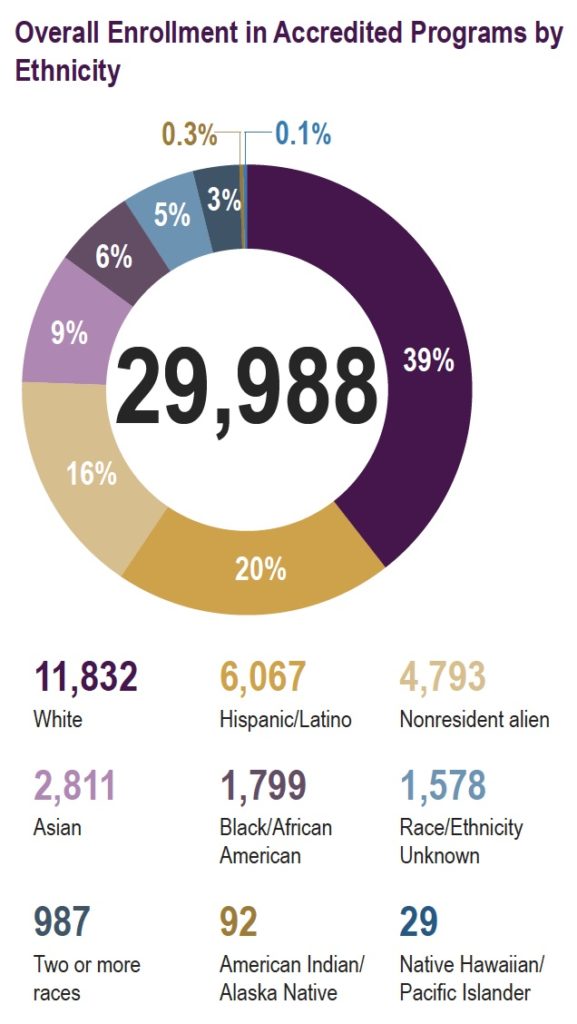NAAB 2022 REPORT ON ARCHITECTURE EDUCATION
Recently, NAAB (National Architectural Accrediting Board) released its annual reports on Architecture Education.
As shared on the NAAB website: “This report, to be produced annually, shares the accreditation decisions made by the NAAB in the previous year, provides a review of the aggregated statistics provided by each accredited program, and reports on other activities.”
2022_NAAB_Annual_Report on Architecture Education (PDF)
https://www.naab.org/accreditation/publications/
2022_NAAB_Report on Architecture Education at Minority-Serving Institutions (PDF)
https://www.naab.org/accreditation/publications/
For this week’s essay, we will focus on the first of the two reports and more specifically, the aggregated statistics of the accredited programs. Below are more details on accredited programs, enrollment, and degrees awarded.
Note: Definitions used in these NAAB reports are based on the glossary of terms used. Integrated Postsecondary Education Data System (IPEDS). IPEDS is the “core postsecondary data collection program” for the National Center for Education Statistics. Data are collected from all primary providers of postsecondary education in the United States in areas including enrollments, program completions, graduation rates, faculty, staff, finances, institutional prices, and student financial aid.
We strongly encourage you to use IPEDS to research institutions you may be considering for your college choice.
Accredited Programs
In AY 2021–22, 172 accredited programs were housed in 137 institutions with U.S. regional accreditation. Of the 172 programs, 116 (67%) are Master of Architecture programs, 55 (32%) are Bachelor of Architecture programs, and 1 (1%) is a Doctor of Architecture program.
There are also an additional six programs with eligibility preparing for initial candidacy programs. As well, there are ten programs in candidacy preparing for continuation of candidacy. See the report for the institutions in the candidacy process.
Enrollment
There are 29,988 students enrolled in NAAB-accredited degree programs: of this total, 17,082 (60%) are enrolled in Bachelor of Architecture programs, 12,006 (40%) in either Master of Architecture programs, or Doctor of Architecture programs.
Overall, enrollment in accredited programs increased by a net of 2,071 students, or 7%, from AY 2020–21, when 27,917 students were enrolled in accredited degree programs.
Enrollment by Gender
The gender breakdown of enrolled students is 14,216 (47%) males and 15,772 (53%) females. In 2020–21, the percentage breakdown was 49% male students and 51% female students. The percentages are statistically the same for the B. Arch. and M. Arch degrees. The D. Arch. degree percentages were 59% for males and 41% for females.
Enrollment by Ethnicity

Additional information in on Enrollment by Candidate Programs, First Time Enrollment and Preprofessional Programs. For those details, access the full report as noted at the top. Thus, if you combine the total enrollment of accredited programs with that preprofessional programs, the total number of students equals 47,990. For comparison, NCARB reports there are 119,906 (NBTN 2023).
Degrees Awarded
A total of 6,459 accredited degrees were awarded in AY 2021–22: 3,660 (567%) were M. Arch. And D. Arch. degrees; 2,799 (43%) were B. Arch. degrees.
Trends in Enrollment and Degrees Awarded

Now, what does this all mean. First and foremost, it helps you understand the state of architectural education on the macro scale. Perhaps, you know the number of students at your institution, but did you know the total number of architecture students in the country.
Next, the number of architecture students has NOT changed much over the past ten years. While we are not aware of the trend in other academic majors, it begs the question what trends exist with other majors.
Finally, download the full report and review.
